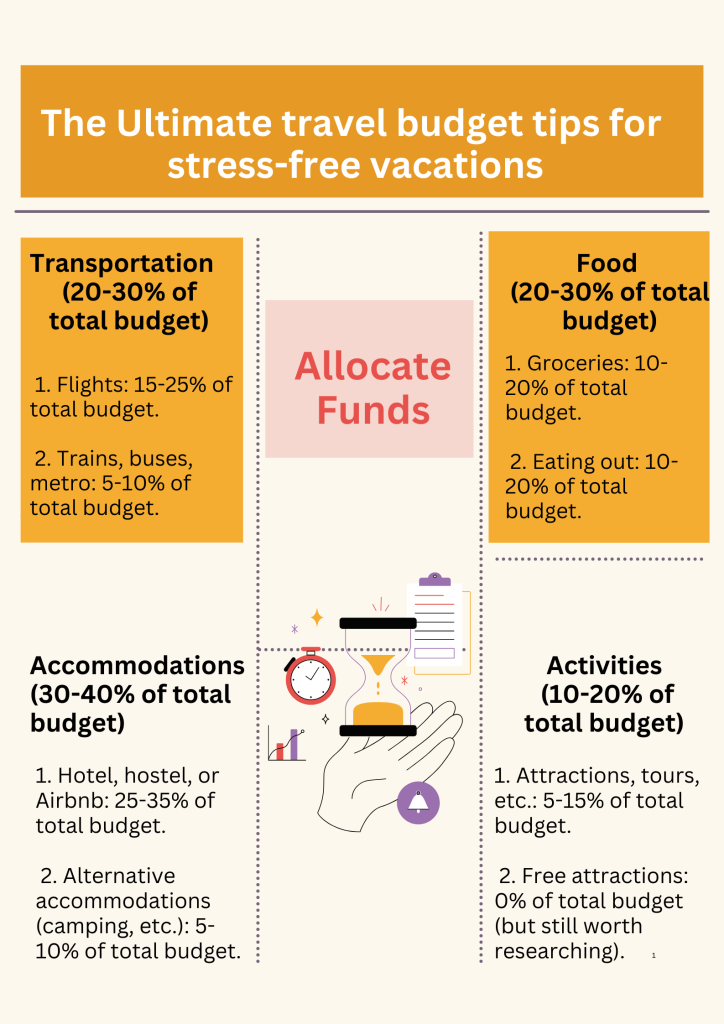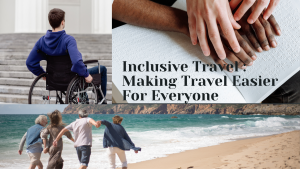Simple Ways to Avoid Travel Stress From Start to Finish

Planning a stress-free vacation should be an exciting experience, not a stressful one. Yet, many travelers find themselves overwhelmed with details of flights, accommodations, packing, and itineraries. The good news is that with the right vacation planning strategies, you can enjoy a seamless and stress-free trip.
Whether you’re traveling solo, with family, or on a budget, these expert travel planning tips will help you stay organized, relaxed, and fully present during your journey. Let’s dive into the best ways to ensure a stress-free trip planning experience and a hassle-free getaway.

Plan Smart for a Smooth Trip
A well-structured travel itinerary is key to an enjoyable and stress-free vacation. Here’s how to get started:
Set a Realistic Budget
Budgeting ahead of time ensures you don’t overspend. Look for budget travel tips, compare
flight prices, and allocate funds for food, transportation, and activities.
If you are wondering how to create a travel budget, start by listing all expected expenses and setting spending limits.
Budget Travel Tips
- Travel during the off-season: Prices for accommodations and flights often drop during the off-season.
- Book accommodations outside city centers: Consider staying in neighborhoods or towns outside the main tourist areas for lower prices.
- Use public transportation: Instead of renting a car or taking taxis, use buses, trains, or metro lines to get around.
- Cook your own meals: Instead of eating out for every meal, consider booking accommodations with a kitchen or kitchenette.
- Free attractions: Research free attractions and activities in your destination, such as visiting local markets or hiking in nearby parks.
Compare Flight Prices
- Use flight comparison websites: Websites like Skyscanner, Kayak, or Google Flights can help you compare prices across different airlines and book the best deals.
- Be flexible with your travel dates: Prices can vary depending on the day of the week and time of year.
- Consider alternative airports: If you have multiple airport options, check prices for each to see if you can find a better deal.
- Book in advance: Generally, the earlier you book, the better your chances of getting a lower price.
Example Budget Breakdown
Let’s say your total budget for the trip is $2,000.
Transportation: $400-600 (20-30% of total budget)
Flights: $300-500
Trains, buses, metro: $100-200
Accommodations: $600-800 (30-40% of total budget)
Hotel, hostel, or Airbnb: $500-700
Alternative accommodations: $100-200
Food: $400-600 (20-30% of total budget)
Groceries: $200-400
Eating out: $200-400
Activities: $200-400 (10-20% of total budget)
Attractions, tours, etc.: $150-300
Free attractions: $0 (but still worth researching!)
Remember, this is just a rough breakdown, and you can adjust the categories based on your specific needs and preferences.

Book Accommodations Early
Avoid last-minute hotel stress by reserving accommodations well in advance. Consider options with free cancellations for flexibility. When choosing where to stay, research the best travel destinations for stress-free vacations to ensure a truly relaxing getaway.
Research Your Destination
Knowing the basics—local transportation, emergency contacts, cultural norms, and visa
requirements—helps you avoid unnecessary stress. If you are unsure how to choose the perfect vacation destination, consider factors such as weather, activities, and budget-friendly options.
Travel Tip: Use Google Maps to save locations in advance so you can navigate easily without internet access.
Pack Smart with a Travel Checklist
Nothing is more stressful than realizing you forgot something essential. Stay organized with this
vacation checklist:
Essential Travel Documents – Passport, ID, tickets, visa, travel insurance, and itinerary.
Essential Travel Documents
- Passport: Make sure it’s valid for at least six months beyond your return date.
- Visa: Check if you need a visa for your destination and apply in advance.
- Travel insurance: Consider purchasing travel insurance to cover unexpected medical or travel-related expenses.
- Flight itinerary: Print or save your flight itinerary and hotel reservation.
- Travel adapter: Bring a travel adapter for charging your devices in foreign outlets.

Comfort Items
- Travel pillow: Invest in a comfortable travel pillow for long flights or car rides.
- Eye mask: Bring an eye mask to block out light and sleep better.
- Earplugs: Pack earplugs to reduce noise and sleep more soundly.
- Favorite snack: Bring a favorite snack to munch on during travel.
- Water bottle: Stay hydrated with a refillable water bottle.
Weather-Appropriate Clothing – Check the weather forecast to pack accordingly.
- Check the forecast: Research the weather forecast for your destination and pack accordingly.
- Layers: Pack clothing that can be layered for different weather conditions.
- Rain gear: Bring a lightweight rain jacket or umbrella if there’s a chance of rain.
- Warm clothing: Pack warm clothing for cold destinations, including a hat, gloves, and scarf.
- Comfortable shoes: Bring comfortable shoes for walking and exploring.
Packing Cubes – Keep your luggage neat and easy to navigate.
- Use packing cubes: Packing cubes can help you organize your luggage and find what you need quickly.
- Separate clothing : Use separate cubes for clothing, toiletries, and electronics.
- Roll clothing : Roll your clothing to save space and reduce wrinkles.
- Use every available space : Make the most of your luggage space by filling any gaps with smaller items.
- Label your cubes : Label your packing cubes so you can easily identify what’s inside.
Additional Tips
- Pack lightly : Try to pack lightly to avoid checking bags and reduce luggage fees.
- Wear bulky items : Wear your bulkiest items, such as your coat and boots, on the plane to save space in your luggage.
- Use a carry-on : Use a carry-on bag for essentials, such as your passport, phone charger, and medication.
- Leave non-essentials behind : Consider leaving non-essential items behind to save space and weight in your luggage.
- Check with your airline : Check with your airline for luggage restrictions and requirements before your trip.
Reduce Airport and Transportation Stress
Whether you’re flying or taking a road trip, these stress-free travel tips will ensure a smooth
journey:
Air Travel Tips for a Hassle-Free Experience:
Arrive at the airport at least 2-3 hours early for international flights.
- Check-in online: Check-in online 24 hours before your flight to print or download your boarding pass.
- Know the airport layout: Familiarize yourself with the airport layout by checking the airport’s website or app.
- Plan for traffic and parking: Leave extra time for traffic and parking by checking traffic updates and reserving airport parking in advance.
- Take advantage of airport amenities: Use the extra time to grab a bite to eat, do some shopping, or relax in an airport lounge.
Use mobile check-in and digital boarding passes.
- Use mobile check-in and digital boarding passes.
- Download airline apps: Download airline apps, such as American Airlines or Delta, to access mobile check-in and digital boarding passes.
- Check-in on your phone: Check-in on your phone and receive your digital boarding pass via email or text message.
- Use TSA Pre-Check or Global Entry: Consider using TSA Pre-Check or Global Entry to speed up security screening.
- Keep your phone charged: Make sure your phone is fully charged and easily accessible to show your digital boarding pass.
Pack liquids in TSA-approved sizes to avoid security delays.
- Use TSA-approved containers: Use containers that meet TSA’s 3.4 oz or less liquid, gel, or aerosol requirement.
- Pack liquids in a clear bag: Pack liquids in a clear, quart-sized zip-top bag for easy screening.
- Declare liquids and gels: Declare liquids and gels at security checkpoints to avoid delays.
Road Trip Essentials
- Plan rest stops to stay refreshed and alert.
- Use GPS apps for real-time traffic updates and alternate routes.
- Pack a snack kit to minimize unnecessary food stops.
Vehicle Maintenance
- Check oil and fluids: Check engine oil, transmission fluid, coolant, and brake fluid levels before embarking on your trip.
- Tire pressure and condition: Check tire pressure and condition to ensure they’re safe for long-distance driving.
- Battery and electrical system: Check the battery, starter, and electrical system to ensure they’re functioning properly.
- Air filter and belts: Check the air filter and belts to ensure they’re clean and in good condition.
- Schedule a maintenance check: Schedule a maintenance check with a mechanic before your trip to identify any potential issues.
Pack an Emergency Kit
- Jumper cables: Include jumper cables in case of a dead battery.
- Spare tire and tire-changing equipment: Pack a spare tire, lug wrench, and car jack in case of a flat tire.
- First aid kit: Include a first aid kit with essentials like bandages, antiseptic wipes, and pain relievers.
- Flashlight and extra batteries: Pack a flashlight and extra batteries in case of a breakdown or accident.
- Reflective triangles or road flares: Include reflective triangles or road flares to alert other drivers in case of a breakdown.
Pack Snacks Kit
- Non-perishable snacks: Pack non-perishable snacks like nuts, dried fruits, and energy bars.
- Fresh fruit and vegetables: Include fresh fruit and vegetables like apples, oranges, and carrots.
- Bottled water and refillable containers: Pack bottled water and refillable containers to stay hydrated.
- Coffee and tea: Include coffee and tea for a caffeine boost during long drives.
- Snack-sized meals: Pack snack-sized meals like sandwiches, crackers, and cheese.
Use GPS or Mapping App
- Real-time traffic updates: Use a GPS or mapping app like Waze or Google Maps to get real-time traffic updates.
- Alternate routes: Use the app to find alternate routes in case of traffic congestion or road closures.
- Points of interest: Use the app to find points of interest like restaurants, gas stations, and rest stops.
- Offline maps: Download offline maps to use the app even without cellular service.
Plan Rest Stops
- Every few hours: Plan to stop every few hours to stretch your legs, get some fresh air, and rest your eyes.
- Rest stops and welcome centers: Use rest stops and welcome centers to take a break and get information about the local area.
- Gas stations and convenience stores: Use gas stations and convenience stores to refuel, grab a snack, and use the restroom.
- Parks and picnic areas: Use parks and picnic areas to take a break, enjoy a meal, and stretch your legs.
What To Do
- Get enough sleep: Get enough sleep before embarking on your trip to ensure you’re well-rested and alert.
- Stay hydrated: Stay hydrated by drinking plenty of water throughout your trip.
- Take turns driving: Take turns driving to avoid fatigue and give each other a break.
- Enjoy the scenery: Enjoy the scenery and take in the sights along the way.

Family-Friendly Travel Tips:
Stay Organized
Stay organized by keeping all travel documents, including boarding passes and hotel reservations, in one place.
Keep Kids Entertained
- Travel-friendly games: Pack travel-friendly games like Uno, Trouble, or travel-sized board games that are easy to play in a car or airplane.
- Tablets and handheld consoles: Bring tablets or handheld consoles loaded with kids’ favourite games, apps, and movies to keep them entertained during travel.
- Colouring books and crayons: Pack colouring books, crayons, and markers to keep kids creative and occupied during travel.
- Audiobooks and podcasts: Play audiobooks or kid-friendly podcasts during car rides or flights to keep kids engaged and entertained.
Stick to Familiar Mealtimes and Bring Snacks
- Pack familiar snacks: Bring familiar snacks like goldfish crackers, fruit, or granola bars to keep kids satisfied during travel.
- Stick to routine mealtimes: Try to stick to familiar mealtimes and routines to help kids feel more secure and comfortable during travel.
- Bring refillable water bottles: Bring refillable water bottles to keep kids hydrated during travel and reduce waste.
- Research kid-friendly restaurants: Research kid-friendly restaurants and cafes at your destination to ensure there are options that cater to picky eaters.
Book Kid-Friendly Accommodation
- Look for play areas and amenities: Book accommodations with play areas, game rooms, or kid-friendly amenities like pools or water parks.
- Check for kid-friendly services: Check if the accommodation offers kid-friendly services like babysitting, kids’ clubs, or children’s activities.
- Choose a family-friendly room type: Choose a room type that suits your family’s needs, such as a suite or a room with a separate living area.
- Read reviews from other families: Read reviews from other families to get a sense of the accommodation’s suitability for kids and families.
What To Do
- Be prepared for meltdowns: Travel can be overwhelming for kids, so be prepared for meltdowns and have a plan in place to calm them down.
- Build in downtime: Build in downtime to your travel schedule to allow kids to rest and recharge.
- Make travel a learning experience: Make travel a learning experience by encouraging kids to try new foods, learn about different cultures, and explore new places.
- Take turns with your partner: Take turns with your partner to give each other a break and allow for some adult time during travel.
Balance Sightseeing with Relaxation
Overloading your schedule can turn an exciting trip into an exhausting one. Instead, create a
balanced itinerary:
- Schedule Downtime – Plan spa days, beach lounging, or leisurely city walks.
- Enjoy Slow Dining – Take the time to savor local cuisine instead of rushing meals.
- Capture Memories – But don’t let social media take over your experience!
- Always leave buffer time between activities to allow for unexpected delays or extra
relaxation.
Here are some practical explanations for creating a balanced itinerary:
Schedule Downtime
- Leave gaps in your itinerary: Don’t overschedule your day. Leave gaps for relaxation, spontaneity, and flexibility.
- Plan relaxation days: Set aside days for relaxation, whether it’s lounging on the beach, getting a massage, or taking a leisurely stroll.
- Take breaks: Take breaks throughout the day to rest and recharge. This could be as simple as taking a short nap, reading a book, or enjoying a cup of coffee.
- Prioritize sleep: Prioritize sleep and aim for 7-8 hours of rest each night to ensure you’re well-rested and energized for the next day.

Plan Spa Days, Beach Lounging, or Leisurely City Walks
- Book spa treatments in advance: Book spa treatments like massages, facials, or yoga classes in advance to ensure availability.
- Choose a beach with amenities: Choose a beach with amenities like umbrellas, chairs, and food and drink service to make your lounging experience more enjoyable.
- Research city walking tours: Research city walking tours or self-guided walking routes to explore local neighborhoods and landmarks at a leisurely pace.
- Consider a scenic drive: Consider a scenic drive or a boat tour to enjoy the local scenery and relax.
Enjoy Slow Dining
- Research local restaurants: Research local restaurants and make reservations in advance to ensure availability.
- Choose restaurants with a relaxed atmosphere: Choose restaurants with a relaxed atmosphere, like outdoor seating or a cozy interior, to enhance your dining experience.
- Take your time: Take your time during meals, savoring each bite and enjoying the company of your travel companions.
- Try local specialties: Try local specialties and street food to experience the authentic flavors of your destination.
Capture Memories
- Bring a camera: Bring a camera or phone with a good camera to capture memories of your trip.
- Take notes: Take notes or write in a journal to record your thoughts, feelings, and experiences.
- Collect souvenirs: Collect souvenirs like postcards, brochures, or local handicrafts to remember your trip.
- Create a photo album: Create a photo album or scrapbook after your trip to preserve your memories and share them with others.
What To Do
- Be flexible: Be flexible and adapt to changes in your itinerary or unexpected events.
- Communicate with your travel companions: Communicate with your travel companions to ensure everyone is on the same page and having a good time.
- Take care of yourself: Take care of yourself by staying hydrated, eating well, and getting enough rest.
- Enjoy the journey: Enjoy the journey and don’t stress too much about the details. Remember, it’s about the experience, not just the destination.
Prepare for the Unexpected
Even the best vacation planning tips can’t prevent everything. Be ready for surprises with these
smart travel strategies:
- Keep Digital and Physical Copies also have backups of important documents.
- Download Essential Travel Apps like Google Maps, language translators, and currency
- converters.
- Invest in Travel Insurance that covers trip cancellations, medical emergencies, and lost luggage.
- Stress-Free Travel Mindset: Flexibility is key factor that things may not always go as planned, and that’s alright.
Final Thoughts
Make Your Next Vacation Truly memorable by following these simple but proven ways to avoid travel stress. Time to turn travel anxiety into pure relaxation.
Prioritize smart vacation planning, self-care, and stress-free family vacations to make every trip more enjoyable.
Ready for your next relaxing getaway? Start planning now and enjoy a truly stress-free vacation!




